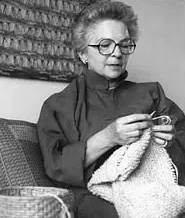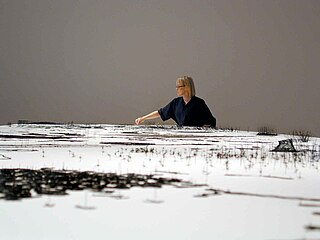Related Research Articles

Anni Albers was a German textile artist and printmaker credited with blurring the lines between traditional craft and art.
Besides surface qualities, such as rough and smooth, dull and shiny, hard and soft, textiles also includes colour, and, as the dominating element, texture, which is the result of the construction of weaves. Like any craft it may end in producing useful objects, or it may rise to the level of art.

Lenore Tawney was an American artist working in fiber art, collage, assemblage, and drawing. She is considered to be a groundbreaking artist for the elevation of craft processes to fine art status, two communities which were previously mutually exclusive. Tawney was born and raised in an Irish-American family in Lorain, Ohio near Cleveland and later moved to Chicago to start her career. In the 1940's and 50's, she studied art at several different institutions and perfected her craft as a weaver. In 1957, she moved to New York where she maintained a highly successful career into the 1960's. In the 1970's Tawney focused increasingly on her spirituality, but continued to make work until her death.

Mary Walker Phillips, was an American textile artist, author and educator. She revolutionized the craft of hand knitting by exploring knitting as an independent art form. Her hand-knit tapestries and other creative pieces are exhibited in museums in the U.S. and Europe. She was honored as a fellow by the American Craft Council (ACC) in 1978.
Arline Fisch is an American artist and educator. She is known for her work as a metalsmith and jeweler, pioneering the use of textile processes from crochet, knitting, plaiting, and weaving in her work in metal. She developed groundbreaking techniques for incorporating metal wire and other materials into her jewelry.

Mary Lee Hu is an American artist, goldsmith, and college level educator known for using textile techniques to create intricate woven wire jewelry.

Anne Wilson is a Chicago-based visual artist. Wilson creates sculpture, drawings, Internet projects, photography, performance, and DVD stop motion animations employing table linens, bed sheets, human hair, lace, thread and wire. Her work extends the traditional processes of fiber art to other media. Wilson is a professor in the Department of Fiber and Material Studies at The School of the Art Institute of Chicago.

Dorothy Wright Liebes was an American textile designer and weaver renowned for her innovative, custom-designed modern fabrics for architects and interior designers. She was known as "the mother of modern weaving".

Sonya Clark is an American artist of Afro-Caribbean heritage. Clark is a fiber artist known for using a variety of materials including human hair and combs to address race, culture, class, and history. Her beaded headdress assemblages and braided wig series of the late 1990s, which received critical acclaim, evoked African traditions of personal adornment and moved these common forms into the realm of personal and political expression. Although African art and her Caribbean background are important influences, Clark also builds on practices of assemblage and accumulation used by artists such as Betye Saar and David Hammons.

Trude Guermonprez, born Gertrud Emilie Jalowetz, was a German]-born American textile artist, designer and educator, known for her tapestry landscapes. Her Bauhaus-influenced disciplined abstraction for hand woven textiles greatly contributed to the American craft and fiber art movements of the 1950s, 60s and even into the 70s, particularly during her tenure at the California College of Arts and Crafts.
Kay Sekimachi is an American fiber artist and weaver, best known for her three-dimensional woven monofilament hangings as well as her intricate baskets and bowls.

Marianne Strengell was an influential Finnish-American Modernist textile designer in the twentieth century. Strengell was a professor at Cranbrook Academy of Art from 1937 to 1942, and she served as department head from 1942 to 1962. She was able to translate hand-woven patterns for mechanized production, and pioneered the use of synthetic fibers.

Yoshiko Iwamoto Wada is a Japanese textile artist, curator, art historian, scholar, professor, and author. She has received international recognition for her scholarship and expertise in the field of textile art. In 2010, she was named a "Distinguished Craft Educator - Master of Medium" by the James Renwick Alliance of the Smithsonian Institution, who stated: "she is single-handedly responsible for introducing the art of Japanese shibori to this country". In 2016 she received the George Hewitt Myers Award for Lifetime Achievement.

Helena Hernmarck is a Swedish tapestry artist who lives and works in the United States. She is best known for her monumental tapestries designed for architectural settings.
Lia Cook is an American fiber artist noted for her work combining weaving with photography, painting, and digital technology. She lives and works in Berkeley, California, and is known for her weavings which expanded the traditional boundaries of textile arts. She has been a professor at California College of the Arts since 1976.
Linda Threadgill is an American artist whose primary emphasis is metalsmithing. Her metal work is inspired by forms of nature and the interpretations she gleans from the intricate patterns it presents. She explores the foundation of nature to allude to nature and transform it into re-imagined, stylized plants forms.
Nell Znamierowski was an American textile artist.
Ethel Stein (1917–2018) was an American textile artist who lived in Croton-on-Hudson, N.Y. While her work was primarily in weaving, her best known piece is the puppet Lamb Chop.

Lili Blumenau (1912–1976) was an American fiber artist. She was a pivotal figure in the development of fiber arts and textile arts, particularly weaving, in the United States during the mid-part of the 20th century.

Mary Zicafoose is an American textile artist, weaver, and teacher who specializes in ikat, an ancient technique in which threads are wrapped, tied and resist-dyed before weaving. Zicafoose is the author of Ikat: The Essential Handbook to Weaving Resist-Dyed Cloth (2020). Her works are part of private and public collections, including at least 16 embassies around the world as part of the U.S. Art in Embassies Program.
Betty Scarpino is an American wood sculptor active in Indianapolis, Indiana. She received the Windgate International Turning Exchange Resident Fellowship two times - once in 1999 and another in 2016 - making her the second person in the residency's history to be chosen twice. In 2020, she was awarded an Honorary Lifetime Member from the American Association of Woodturners (AAW) for her contributions to the advancement of woodturning. Her work is currently in the Smithsonian American Art Museum's collection and The Center for Art in Wood Museum's collection.
References
- 1 2 3 4 5 Jules Heller; Nancy G. Heller (2013). North American Women Artists of the Twentieth Century: A Biographical Dictionary. Taylor & Francis. pp. 2526–27. ISBN 978-1-135-63889-4.
- 1 2 3 4 5 6 "Oral history interview with Cynthia Schira, 2001 July 25-26". Archives of American Art . Retrieved 23 January 2015.
- 1 2 3 4 "Museum To Show Wall Hangings, Fiber Sculpture". Iowa City Press-Citizen . June 27, 1973.
- 1 2 3 4 "Cynthia Schira". Cooper-Hewitt . Retrieved 23 January 2015.
- 1 2 Koplos, Janet. (2010). Makers : a history of American studio craft . Metcalf, Bruce, 1949-, Center for Craft, Creativity & Design. Chapel Hill: University of North Carolina Press. pp. 356, 469. ISBN 9780807895832. OCLC 658203695.
- 1 2 3 "Cynthia Schira". American Craft Council. Archived from the original on 15 October 2013. Retrieved 23 January 2015.
- ↑ "Cynthia Schira". Smithsonian American Art Museum . Retrieved 23 January 2015.
- ↑ "Cynthia Schira | Smithsonian American Art Museum". americanart.si.edu.
- 1 2 3 Renault, Val Alexander (October 23, 1998). "KU design professor to receive career teaching award". University of Kansas. Archived from the original on 22 January 2015. Retrieved 23 January 2015.
- ↑ https://www.linkedin.com/pub/cynthia-schira/19/841/303 [ self-published source ]
- ↑ "Cynthia Schira: Oral History Project" (PDF). KU Retirees' Club. Archived from the original (PDF) on 22 January 2015. Retrieved 23 January 2015.
- ↑ "Cynthia Schira | Smithsonian American Art Museum". americanart.si.edu. Retrieved 2016-01-25.
- ↑ 1982 NEA Artists Fellowships. American Craft, 42(6), 2-7.
- ↑ "American Craft Council College of Fellows | American Craft Council". Archived from the original on 2013-04-30. Retrieved 2014-04-26., American Craft Council website, American Craft Council College of Fellows.
- ↑ "American Craft Council Gold Medalists | American Craft Council". Archived from the original on 2014-01-24. Retrieved 2014-10-11., American Craft Council website, American Craft Council Gold Medalists.
- ↑ "Textile, 1984". Cooper-Hewitt . Retrieved 23 January 2015.
- ↑ "Cynthia Schira: Within the Dream". Metropolitan Museum of Art . Retrieved 23 January 2015.
- ↑ "Reflections by Cynthia Schira". Smithsonian American Art Museum . Retrieved 23 January 2015.
- ↑ "Lake Summer by Cynthia Schira". Smithsonian American Art Museum . Retrieved 23 January 2015.
- ↑ "Table/Cloth by Cynthia Schira". Smithsonian American Art Museum . Retrieved 23 January 2015.
- ↑ "An Errant Line: Ann Hamilton / Cynthia Schira | Exhibitions | Spencer Museum of Art". www.spencerart.ku.edu. Retrieved 2016-01-25.